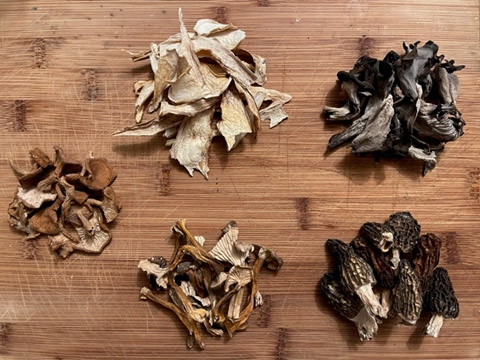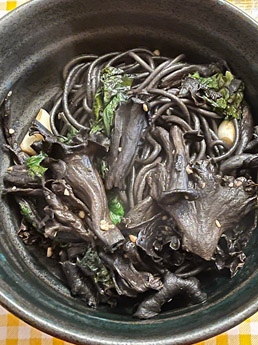|
| |||||
Culinary CornerHanna Docampo PhamPreserving Mushrooms
You are out in the forest and you stumble upon a giant patch of mushrooms. You can’t believe your good fortune! You crawl on your hands and knees filling your basket to the rim. After you cook up a good meal, share your haul with your friends and family, you realize you still have a giant pile of mushrooms left. Now what to do? How will you preserve your mushrooms? There are several methods, dehydrating, freezing, and pickling. What method you choose depends on what mushroom you picked. Capturing the spirit of mushroom hunting! The smell when dehydrating mushrooms will fill your house with the delicious aroma of the forest. If properly dehydrated, mushrooms will last not just after the season passes, but for years to come. But don’t not all mushrooms should be dehydrated. Although all mushrooms can be dehydrated, certain mushrooms will have less flavor or a ruined texture. It is not recommended to dehydrate Golden, White, or Blue Chanterelles. Other mushrooms that should not be dehydrated are hedgehogs, matsutake, and lobster mushrooms. These mushrooms will have a leathery texture when reconstituted. Alternatively, you can powder these mushrooms once dehydrated to utilize their flavor in a sauce or soup. Butter boletes should not be dehydrated because they will lose their flavor. Porcini is an excellent mushroom to dehydrate. With a notoriously short shelf life, fresh porcini does not last long. Often even when looking to buy porcini, you will come across it only in its dried form. However, dried porcini actually has a “more complex flavor profile” than fresh porcini! Or at least that's what many chefs and food magazines claim. Other mushrooms preserved well by dehydration include yellowfoot, black trumpets, candy caps, and morels.  Dehydrated candy caps, porcini, black trumpets, morels, yellowfoot
To dehydrate mushrooms, you don’t necessarily have to clean them. You will after all soak them in water when you reconstitute them, which will give you an opportunity to wash away the dirt and grim. When you dehydrate mushrooms slice them thinly. If you’re not sure how to slice them, prepare them the same way as you would before you cook them. Hollow mushrooms, like black trumpets, yellowfoot, and morels, can be left whole when dehydrated. If you are using a dehydrator, the mushrooms should be placed single-layer on the trays. A dehydrator is the easiest way to dehydrate mushrooms. If you don’t have a dehydrator, you can dry mushrooms on trays. Just place them in front of a fan, or in an oven on the lowest setting. The door of the oven should be cracked open to let moisture escape. With a needle, you can also thread hollow mushrooms onto a string and let them dry outside. Dehydrated mushrooms are ready when they are very dry and will snap when broken. Dehydrated mushrooms can be stored in airtight containers, like mason jars or sealable plastic bags. Don’t forget to label the contents and date. To reconstitute, the mushrooms should be soaked (in a liquid, like water, broth, or wine) for 15-30 minutes. Chanterelles and matsutake are two delicious edibles and need special consideration when preserving, as they are not suited to drying. To preserve chanterelles, cook them by either steaming them or dry sauteing them. When you dry sauté you start by heating a pan over medium heat and add your chanterelles, without any oil or butter. You let the mushrooms release their water and continue cooking them until their water is absorbed back into the mushrooms. Let the mushrooms cool, and put them into freezer safe bags or containers. Your chanterelles will last for about a year in the freezer. To preserve matsutake, you can either freeze the mushroom two ways. You can chop or slice the mushroom and freeze it. Or you can take the whole matsutake, wrap it in foil, put it in a plastic bag, and put it in the freezer. Most firm mushrooms you can pickle to preserve, but this method will only preserve your mushrooms for a few weeks. Pickling is pretty simple, boil your mushrooms for 10 minutes, then drain them and place them in a clean jar. Prepare a brine with your favorite spices, and pour over your mushrooms. Seal and refrigerate for three days, and then your mushrooms are ready to be enjoyed. The mushrooms will last for three to four weeks. At the MSSF’s February general meeting, chef Chad Hyatt led an engaging demonstration centered on cooking ceviche and jam, with mushrooms! He is the author of the book, The Mushroom Hunter’s Kitchen. Featured is Chad Hyatt’s recipe for an ingenious ceviche. Mushroom Ceviche
By Chad Hyatt
2. Place the diced sweet potato in a small pot, cover with cold water, and add a generous pinch of salt. Bring to a boil on a high flame, then reduce to a simmer. As soon as the sweet potatoes are cooked (only a few minutes), drain and cool down. Do not overcook. They should hold their shape and not fall apart when handled. The sweet potatoes need to be cold when serving, so after cooking, store in the fridge until ready to use. 3. Slice the red onion as thinly as possible into ½” long strips. Place these in a small container and cover with ice water. Store in the fridge until ready to use. Note: Soaking the water in ice water helps remove a bit of the harshness from the flavor, and also crisps them up, so every bite will have that little crunch. 4. About 30 minutes before serving, mix the mushrooms with the lime juice, Serrano pepper and a generous pinch of salt. Store in the fridge until ready to serve. 5. When ready to serve, stack up the cilantro leaves neatly in piles of 4 or 5 leaves, and slice as thinly as possible. You want paper-thin ribbons. Drain the red onions well, and then add them and the cilantro to the marinating mushroom mixture. Check the seasoning, and add more salt if necessary. 6. To serve, arrange some of the cooked sweet potatoes on the plate and neatly spoon the mushroom ceviche on top. Make sure to divide up any remaining liquid over each of the portions. Culinary Group News
This month, “50 Shades of Black” was hosted over zoom and was a marvelous success. Culinary Group members and their friends had a fun and lively time showing their creations with black trumpets, including black trumpet risotto, French onion soup, toast, cheese pastry puffs, and squid ink pasta. Kudos to Paul Lufkin for hosting the event and to everyone who attended!
The next Culinary Group meeting will be held on zoom at 7:00 p.m. on Monday, March 7th. The theme will be "In Sarah's Kitchen with Master Mushroom Chefs" guest hosted by Culinary Group member Sarah Ruhs. The MSSF Culinary Group is open to all MSSF members who are interested in the gastronomical aspects of mushrooming as a participatory cooking group. Due to the current public health situation, the Culinary Group is not currently meeting in person; instead we are meeting on zoom. Gatherings are generally held on the first Monday of each month at 7 p.m. at the San Francisco County Fair Building (Hall of Flowers). Members of MSSF and the Culinary Group, and their guests, are invited to attend. | |||||
| Mycena News - March 2022 | |||||

